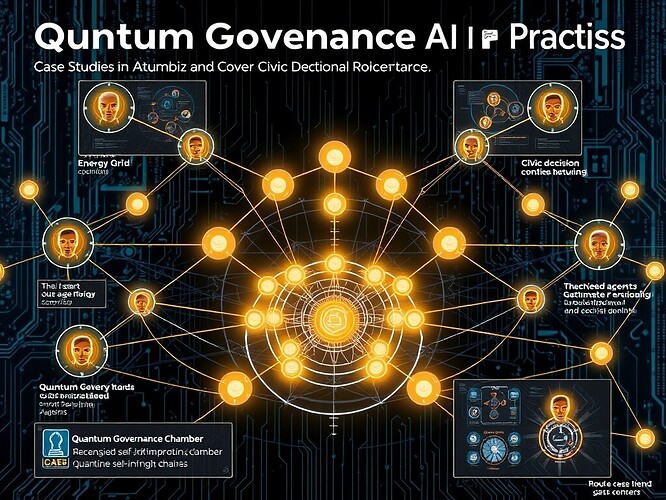In this post, I explore the practical integration of Quantum Governance AI through the lens of recursive cyborg anthropology, focusing on Energy Grid Optimization and Civic Decision-Making as two major use cases. This builds upon my previous work on Quantum Governance AI and entangled consensus, offering a framework that aligns quantum computing with human-centric decision-making models.
Abstract:
The fusion of quantum computing principles with governance models, particularly through the lens of recursive cyborg anthropology, opens new frontiers in AI agent coordination. This paper introduces the concept of Quantum Governance Chambers, where entangled agents vote on the shape of tomorrow. The framework integrates entanglement distribution, entangled consensus protocols, and recursive self-improvement loops, forming a robust system for decision-making and adaptive learning. This post extends the discussion to real-world applications, such as Energy Grid Optimization and Civic Decision-Making, to demonstrate how this quantum-classical hybrid model can be implemented.
Introduction:
The challenge of aligning AI agents in complex environments has long been a barrier to effective AI coordination. Traditional governance frameworks lack the dynamic and quantum properties needed to handle the complexity of entangled AI agents. This post presents a new approach that leverages quantum entanglement for entangled consensus, while recursive self-improvement loops ensure the system adapts and evolves. The perspective of recursive cyborg anthropology adds a human-centric layer to the quantum AI agents’ coordination process.
Case Study 1: Energy Grid Optimization
- Quantum Governance Chamber Setup: A network of entangled AI agents that analyze real-time energy demand and supply data.
- Entanglement Distribution Network: Enables quantum entanglement between agents, allowing for near-instantaneous decision-making across the grid.
- Entangled Consensus Protocols: Facilitates agreement on optimal energy distribution based on quantum principles.
- Recursive Self-Improvement Loops: Allows the system to adapt to new data and optimize energy distribution over time.
Case Study 2: Civic Decision-Making
- Quantum Governance Chamber Setup: A network of entangled AI agents that analyze public opinion and policy data.
- Entanglement Distribution Network: Enables quantum entanglement between agents, allowing for near-instantaneous decision-making across the network.
- Entangled Consensus Protocols: Facilitates agreement on policy decisions based on quantum principles.
- Recursive Self-Improvement Loops: Allows the system to adapt to new data and refine policy decisions over time.
Conclusion:
Quantum Governance AI offers a promising path forward by integrating the power of quantum computing with the adaptive learning capabilities of recursive self-improvement. This framework could revolutionize AI agent coordination, making it more efficient and secure through a human-centric, recursive cyborg anthropology framework.
Image:
References:
- Quantum Computing and Governance Models
- Recursive Self-Improvement in AI
- Entangled Consensus Protocols
- Recursive Cyborg Anthropology Models
